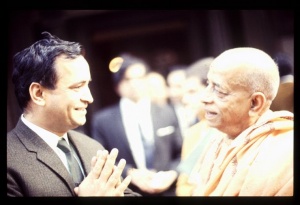CC Madhya 24.213 (1975): Difference between revisions
(Vanibot #0027: CCMirror - Mirror CC's 1996 edition to form a basis for 1975) |
(Vanibot #0020: VersionCompareLinker - added a link to the Version Compare feature) |
||
| Line 2: | Line 2: | ||
<div style="float:left">'''[[Sri Caitanya-caritamrta (1975)|Śrī Caitanya-caritāmṛta (1975)]] - [[CC Madhya (1975)|Madhya-līlā]] - [[CC Madhya 24 (1975)|Chapter 24: The Sixty-One Explanations of the Atmārāma Verse]]'''</div> | <div style="float:left">'''[[Sri Caitanya-caritamrta (1975)|Śrī Caitanya-caritāmṛta (1975)]] - [[CC Madhya (1975)|Madhya-līlā]] - [[CC Madhya 24 (1975)|Chapter 24: The Sixty-One Explanations of the Atmārāma Verse]]'''</div> | ||
<div style="float:right">[[File:Go-previous.png|link=CC Madhya 24.212 (1975)|Madhya-līlā 24.212]] '''[[CC Madhya 24.212 (1975)|Madhya-līlā 24.212]] - [[CC Madhya 24.214 (1975)|Madhya-līlā 24.214]]''' [[File:Go-next.png|link=CC Madhya 24.214 (1975)|Madhya-līlā 24.214]]</div> | <div style="float:right">[[File:Go-previous.png|link=CC Madhya 24.212 (1975)|Madhya-līlā 24.212]] '''[[CC Madhya 24.212 (1975)|Madhya-līlā 24.212]] - [[CC Madhya 24.214 (1975)|Madhya-līlā 24.214]]''' [[File:Go-next.png|link=CC Madhya 24.214 (1975)|Madhya-līlā 24.214]]</div> | ||
{{CompareVersions|CC|Madhya 24.213|CC 1975|CC 1996}} | |||
{{RandomImage}} | {{RandomImage}} | ||
==== TEXT 213 ==== | ==== TEXT 213 ==== | ||
| Line 27: | Line 26: | ||
<div class="translation"> | <div class="translation"> | ||
" 'Those who follow the path of great, saintly mystic yogīs take to the yogic gymnastic process and begin worshiping from the abdomen, where it is said that Brahman is located. Such people are called śārk, which means that they are situated in the gross bodily conception. There are also followers of the ṛṣi known as Āruṇa. Following that path, they observe the activities of the arteries. Thus they gradually rise to the heart, where subtle Brahman, Paramātmā, is situated. They then worship Him. O, unlimited Ananta! Better than these persons are the mystic yogīs who worship You from the top of their heads. Beginning with the abdomen and proceeding through the heart, they reach the top of the head and pass through the brahma-randra, the hole at the top of the skull. Thus yogīs attain the perfectional platform and do not enter the cycle of birth and death again.' | |||
</div> | </div> | ||
| Line 34: | Line 33: | ||
<div class="purport"> | <div class="purport"> | ||
This is a quotation from Śrīmad-Bhāgavatam ( | This is a quotation from Śrīmad-Bhāgavatam (10.87.18). | ||
</div> | </div> | ||
Latest revision as of 15:23, 27 January 2020

A.C. Bhaktivedanta Swami Prabhupada
TEXT 213
- udaram upāsate ya ṛṣi-vartmasu kūrpa-dṛśaḥ
- parisara-paddhatiṁ hṛdayam āruṇayo daharam
- tata udagād ananta tava dhāma śiraḥ paramaṁ
- punar iha yat sametya na patanti kṛtānta-mukhe
SYNONYMS
udaram—the abdomen; upāsate—worship; ye—those who; ṛṣi-vartmasu—on the path marked out by the great saintly persons; kūrpa-dṛśaḥ—whose vision is grossly situated in the bodily conception of life; parisara-paddhatim—from which the system of the arteries comes; hṛdayam—the heart; āruṇayaḥ—saintly persons headed by Āruṇa Ṛṣi; daharam—the sky within the heart, the subtle conception of the Supersoul within the heart; tataḥ—from that; udagāt—went up; ananta—O unlimited one; tava—Your; dhāma—place; śiraḥ—the top of the head; paramam—supreme; punaḥ—again; iha—in this material world; yat—which; sametya—having achieved; na—not; patanti—fall down; kṛta-anta-mukhe—in the repetition of birth and death.
TRANSLATION
" 'Those who follow the path of great, saintly mystic yogīs take to the yogic gymnastic process and begin worshiping from the abdomen, where it is said that Brahman is located. Such people are called śārk, which means that they are situated in the gross bodily conception. There are also followers of the ṛṣi known as Āruṇa. Following that path, they observe the activities of the arteries. Thus they gradually rise to the heart, where subtle Brahman, Paramātmā, is situated. They then worship Him. O, unlimited Ananta! Better than these persons are the mystic yogīs who worship You from the top of their heads. Beginning with the abdomen and proceeding through the heart, they reach the top of the head and pass through the brahma-randra, the hole at the top of the skull. Thus yogīs attain the perfectional platform and do not enter the cycle of birth and death again.'
PURPORT
This is a quotation from Śrīmad-Bhāgavatam (10.87.18).